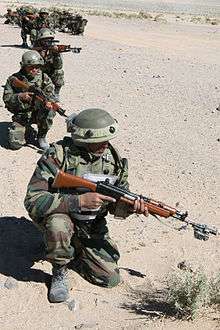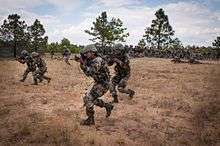Gorkha regiments (India)

Since the independence of India in 1947, as per the terms of the Britain–India–Nepal Tripartite Agreement, six Gorkha regiments, formerly part of the British Indian Army, became part of the Indian Army and have served ever since. The troops are mainly from ethnic Nepali Gurkhas of Nepal and ethnic Nepalese origin people known as Indian Gorkha They have a history of courage in battle, evident from the gallantry awards won by Gorkha soldiers and battle honours awarded to Gorkha both before and after joining the Indian Army. A seventh Gorkha Rifles regiment was re-raised in the Indian Army after Independence to accommodate Gorkha soldiers of 7th Gurkha Rifles and the 10th Gurkha Rifles who chose not to transfer to the British Army.
Origins
Impressed by the fighting qualities displayed by the Gorkhas of Nepal during the Gurkha War, Sir David Ochterlony was quick to realise Gorkha Regiment, was raised as the Nasiri regiment. This regiment later became the 1st King George's Own Gurkha Rifles, and saw action at the Malaun fort under Lieutenant Lawtie.
They were instrumental in the expansion of the British East India Company throughout the subcontinent. The Gorkhas took part in the Gurkha-Sikh War, Anglo-Sikh wars, Afghan wars, and in suppressing the Indian Rebellion of 1857. Throughout these years, the British continued to recruit the Gorkhas and kept increasing the number of Gorkha regiments.
By the time First World War started, there were 10 Gorkha (spelt Gurkha at the time) regiments in the British Indian Army.[1]
The Gorkha regiments played a vital role in the Commonwealth armies during both the World Wars seeing action everywhere from Monte Cassino in the west to Rangoon in the east, earning battle honours everywhere. As a testament to the psychological factors of the Gorkha Regiments on its enemies, during the North African campaign, the German Afrikakorps accorded great respect to the brave Nepalese knife khukri-wielding Gorkhas.
Post-independence

Following India's independence, India, Nepal and Great Britain signed a Tripartite Agreement, and of the total of 10 Gorkha regiments in the British Indian Army, six joined the Indian Army:
- 1st King George V's Own Gurkha Rifles (The Malaun Regiment)
- 3rd Queen Alexandra's Own Gurkha Rifles
- 4th Prince of Wales's Own Gurkha Rifles
- 5th Royal Gurkha Rifles (Frontier Force)
- 8th Gurkha Rifles
- 9th Gurkha Rifles
Following the divisions of the Gorkha regiments, the British Army decided that joining of the British Army would be entirely voluntary for the Gorkha soldiers and decided to hold a referendum. As a result, large numbers of men from the 7th Gurkha Rifles and the 10th Gurkha Rifles, which recruited predominantly from eastern Nepal, decided not to join their regiments as part of the British Army. In order to retain a contingent from this area of Nepal, the Indian Army made the decision to raise the 11 Gorkha Rifles. Although there was an ad hoc regiment raised during World War 1 with troops drawn from the various Gurkha units, the troops mostly retained the uniform and insignias of their respective regiments (with a few exceptions who wore 11 GR badges which was unofficial as no sanction was given for such). This regiment was disbanded in 1922 and has no relation to the present-day 11 Gurkha Rifles, though some do claim so. In 1949, the spelling of 'Gurkha' in the Indian Army was changed to the traditional 'Gorkha', while upon becoming a republic in 1950, all royal titles associated with the Indian Gorkha regiments were dropped.
Since independence, the Gorkhas have fought in every major campaign involving the Indian Army being awarded numerous battle and theatre honours. The regiments have won many gallantry awards like the Param Vir Chakra and the Maha Vir Chakra. The 5 Gorkha Rifles (Frontier Force), has the unique distinction of producing one of the two Field Marshals of the Indian Army, Sam Manekshaw.
The 5th battalion of 5 Gorkha Rifles (Frontier Force), 5/5 GR (FF), fought gallantly in the Hyderabad police action in 1948, during which Nk. Nar Bahadur Thapa of 5/5 GR (FF) earned the first Ashok Chakra Class I of independent India, on 15 September 1948. The 1st battalion, 1/5 GR (FF), captured the Sehjra bulge fighting against a whole Pakistani battalion during the Indo-Pakistani War of 1971. The 4th battalion, 4/5 GR (FF), fought in the Battle of Sylhet, earning the distinction of being the first regiment of the Indian Army to be involved in a heliborne attack. Under the Indian Army, Gorkhas have served in Bangladesh, Sri Lanka, Siachen, and in the UN peacekeeping missions in Lebanon, Sudan and Sierra Leone.
Major Dhan Singh Thapa of the 1st battalion, 8 Gorkha Rifles, 1/8 GR, won the Param Vir Chakra for his heroic actions during the 1962 Sino-Indian conflict. The 1st battalion of the 11 Gorkha Rifles, 1/11 GR, was involved in the Kargil War of 1999 where Lt. Manoj Kumar Pandey won the Param Vir Chakra for his gallant actions.
Current strength

Currently there are 39 battalions serving in 7 Gorkha regiments in the Indian Army. Six regiments were transferred from the British Indian Army, while one was formed after independence;
- 1 Gorkha Rifles - 6 battalions (previously 1st King George V's Own Gurkha Rifles (The Malaun Regiment))
- 3 Gorkha Rifles - 5 battalions (previously 3rd Queen Alexandra's Own Gurkha Rifles)
- 4 Gorkha Rifles - 5 battalions (previously 4th Prince of Wales's Own Gurkha Rifles)
- 5 Gorkha Rifles (Frontier Force) - 6 battalions (previously 5th Royal Gurkha Rifles (Frontier Force))
- 8 Gorkha Rifles - 6 battalions
- 9 Gorkha Rifles - 5 battalions
- 11 Gorkha Rifles - 7 battalions and one TA battalion (107 Inf Bn (11GR) (raised after the independence of India).
The individual Gorkha rifle regiments of India are collectively known for regimental purposes as the 'Gorkha Brigade' between themselves and are not to be confused with the Brigade of Gurkhas of the British Army.
In popular culture
A platoon of the 1/11 Gorkha Rifles, led by Lt. Manoj Kumar Pandey, has been depicted in the Bollywood movie LOC Kargil.
See also
- People of Nepal
- Gurkhas
- Indian Army
- British Indian Army (1858–1947)
- Royal Gurkha Rifles (British Army)
- Brigade of Gurkhas (British Army)
- Gurkha Reserve Unit – (Brunei Police force)
- Gurkha Contingent (Singapore Police Force)